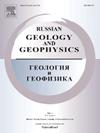Cristobalite Clinker and Paralavas of Ferroan and Melilite–Nepheline Types in the Khamaryn-Khural–Khiid Combustion Methamorphic Complex, East Mongolia: Formation Conditions and Processes
IF 1
4区 地球科学
Q3 GEOSCIENCES, MULTIDISCIPLINARY
引用次数: 0
Abstract
Abstract —Rock samples from the Khamaryn-Khural–Khiid combustion metamorphic (CM) complex, including cristobalite clinker, ferroan tridymite–sekaninaite and cristobalite–fayalite paralavas, which are rock types new to the complex, as well as clinker xenoliths in melilite–nepheline paralava, have been studied in terms of chemistry and mineralogy. The obtained data on rock-forming, minor, accessory, and rare phases (silica polymorphs, cordierite-group minerals, fayalite, Fe and Ti oxides, ferrosilite, etc.) have implications for the formation conditions and processes of the CM rocks. The Raman spectra of sekaninaite, indialite, ferroindialite, mullite, and anhydrous Fe–Ca–Mn phosphate, presumably from the graftonite group, have several specific features. The diversity of mineral assemblages in the CM rocks is due to heterogeneous lithology of the sedimentary protolith and to local effects in the multistage history of the Khamaryn-Khural–Khiid complex. According to geochemical data, all CM rocks of the complex are derived from the Early Cretaceous Dzunbain Formation, their protolith molten to different degrees. The cristobalite clinker and tridymite–sekaninaite and cristobalite–fayalite paralavas were produced by partial melting of pelitic rocks containing different amounts of iron in a wide temperature range. The formation of mullite developed from dehydration–dehydroxylation and incongruent partial melting of amorphous pelitic matter. Large-scale crystallization of mullite in clinker, occurred from the high-silica potassic aluminosilicate melt at >850 °C. Combustion of subsurface coal seams heated the overburden to >1050 °C or locally to >1300–1400 °C (melting point of detrital quartz) or even, possibly, to >1470 °C corresponding to the stability field of β-cristobalite. Melilite–nepheline paralava was formed by incongruent melting of silicate (pelitic) and carbonate (calcite) components of marly limestone under elevated CO2 partial pressure. Oxygen fugacity (fO2) during combustion metamorphism changed from strongly reducing conditions favorable for crystallization of Fe phosphides (barringerite, schreibersite) and metallic iron from silica-undersaturated melts parental to melilite–nepheline paralava to high fO2 values that can maintain the formation of hematite in Fe-rich CM rocks.东蒙古khamarynn - khural - khiid燃烧变质杂岩中铁铁矿和橄榄石-霞石类型的方石石熟料和副石:形成条件和过程
摘要/ Abstract摘要:本文从化学和矿物学方面研究了khamarin - khural - khiid燃烧变质(CM)杂岩的岩石样品,包括该杂岩的新岩石类型——方英石熟料、铁氧体-绢英石和方英石-绢英石副岩,以及方英石-霞石副岩中的熟料捕虏体。获得的岩石形成、次要相、副相和稀有相(二氧化硅多晶岩、堇青石群矿物、铁矾石、铁钛氧化物、硅铁石等)数据对CM岩石的形成条件和过程具有重要意义。绢铁铁矿、独长石、铁独长石、莫来石和无水Fe-Ca-Mn磷酸盐的拉曼光谱具有几个特定的特征。CM岩石中矿物组合的多样性是由于沉积原岩的非均匀岩性和Khamaryn-Khural-Khiid杂岩多阶段历史的局部影响。地球化学资料表明,该杂岩的CM岩均来自早白垩世准班组,其原岩均有不同程度的熔融作用。含铁量不同的泥质岩在较宽的温度范围内部分熔融产生了方英石熟料和绢英石、方英石—绢英石副岩。莫来石的形成是由非晶态泥质脱水-脱羟基作用和不一致部分熔融作用形成的。高硅钾铝硅酸盐熔体在850℃时发生了莫来石在熟料中的大规模结晶。地下煤层的燃烧将覆盖层加热至1050℃或局部加热至1300-1400℃(碎屑石英熔点),甚至可能加热至1470℃(对应于β-方石英的稳定场)。在CO2分压升高的条件下,由泥灰岩中的硅酸盐(泥质)和碳酸盐(方解石)组成的不一致熔融形成。在燃烧变质过程中,氧逸度(fO2)从有利于磷化铁(铁辉石、角闪石)结晶的强还原条件,以及有利于金属铁从硅-欠饱和熔体母体到melilite -霞石副斜斜岩中结晶的高fO2值,转变为有利于维持富铁CM岩石中赤铁矿形成的高fO2值。
本文章由计算机程序翻译,如有差异,请以英文原文为准。
求助全文
约1分钟内获得全文
求助全文
来源期刊

Russian Geology and Geophysics
地学-地球科学综合
CiteScore
2.00
自引率
18.20%
发文量
95
审稿时长
4-8 weeks
期刊介绍:
The journal publishes original reports of theoretical and methodological nature in the fields of geology, geophysics, and geochemistry, which contain data on composition and structure of the Earth''s crust and mantle, describes processes of formation and general regularities of commercial mineral occurrences, investigations on development and application of geological-geophysical methods for their revealing. As to works of regional nature, accelerated publication are available for original papers on a variety of problems of comparative geology taking into account specific character of Siberia, adjacent Asian countries and water areas. The journal will also publish reviews, critical articles, chronicle of the most important scientific events, and advertisements.
 求助内容:
求助内容: 应助结果提醒方式:
应助结果提醒方式:


